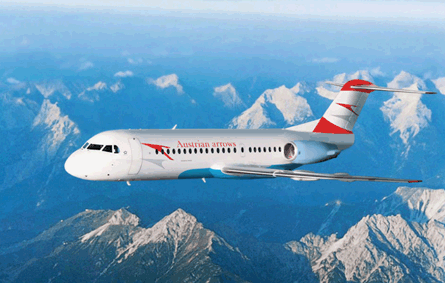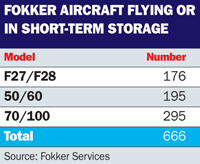Fokker Services is synonymous with Fokker aircraft, but the Dutch company has no intention of withering away as the fleet retires. In 2009 it started supporting Bombardier Dash 8s/Q Series and by the end of the first quarter it will be supporting another type.
"We know regional airlines and the regional market," says president Roland van Dijk.
Of the Dash 8 he adds: "It has a lot of similarities with the Fokker 50 because the principal design is of the same period, so the Dash 8 is an aircraft we feel comfortable with and in terms of power-by-the-hour there was not a lot on offer for the Dash 8."
Fokker is providing power-by-the-hour programmes for Dash 8s in Europe, North America and, as of January, Asia.
 |
|---|
© Austrian ArrowsFokker 70 and 100 operator Austrian is a Fokker Services client |
OUT OF PRODUCTION
Van Dijk declines to name the aircraft type that Fokker Services will add, but says it will be an out-of-production regional aircraft. Possibilities include BAE Systems BAe 146 and Avro jets, the Boeing 717 and Saab 340.
Says van Dijk: "With post-production aircraft there is a difference with the supply chain.
"If the aircraft is in production the original equipment manufacturer takes care of it, but if it is past production then supply chain issues start to appear and that is something we are accustomed to and can handle."
He says Fokker Services is working to address operators' fear that out-of-production aircraft can be expensive to maintain because of a shortage of spare parts. He cites as an example Fokker Services' move last year to take over responsibility for landing gears on Fokker 70/100s.
Fokker Services noticed that the cost of the landing gears was "creeping up", so it approached the OEM, Goodrich, and took over the design drawings and stockpile of parts.
 |
|---|
Fokker then appointed smaller manufacturers to make the landing gears, says van Dijk, adding that the move worked because "we can now control the costs and improve the availability of spares".
The Dutch firm also has 150 engineers whose work includes re-engineering parts so that aircraft operators no longer have to rely solely on OEMs for spares.
Van Dijk says supporting out-of-production aircraft can be a headache for some larger OEMs because they are used to working on major programmes with large production runs. As a consequence, some OEMs are happy to let companies such as Fokker Services take over, he says.
As well as adding new aircraft types to its portfolio, Fokker Services is getting active in helping to re-market Fokker aircraft.
"We realised that the Fokker fleet is relatively small," van Dijk says. "Some of these re-marketers have quite a broad range of aircraft and they don't necessarily focus on Fokker."
Fokker Services decided it "can help these companies to pitch to operators" with a tailor-made service says van Dijk: "If we don't do that then operators won't consider Fokker."
It has also teamed with Denim Air, Montenegro Air and Romania's Carpatair to offer a Fokker wet-lease programme to start-up operators. Fokker 50 operator Denim Air has since entered administration, but Carpatair and Montenegro Air are in line for Fokker 100 services.
With a wet-lease package of aircraft, crew, maintenance and insurance, a new airline can focus on establishing its infrastructure. "We can get you in the air in six weeks," says van Dijk.
Today about 75% of Fokker Services' revenues come from supporting the Fokker fleet, but van Dijk is aiming to pull that to below 40% in 10 years.
TECHNICAL LIFE
However, van Dijk talks up the future of the Fokker fleet, especially the Fokker 50, 70 and 100, the last three Fokker types made before manufacturing ceased in the late 1990s. "If you look at the technical life of the aircraft there is 25 years to go in them," he says. "The design life is 90,000 cycles and on average [the aircraft] are below half that."
Hence, he says, the Fokker 50, Fokker 70 and Fokker 100 will be competitive for commercial airlines "for at least 10 years".
Source: Flight International























